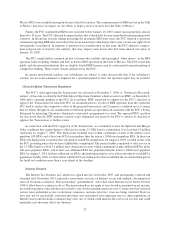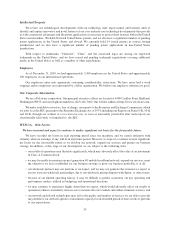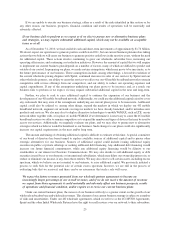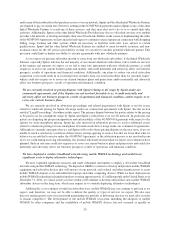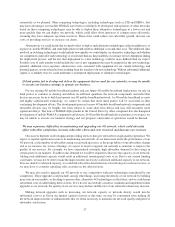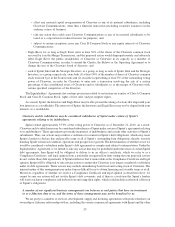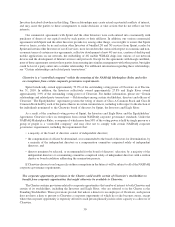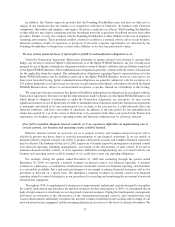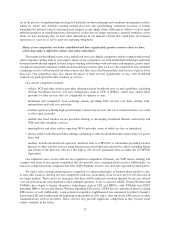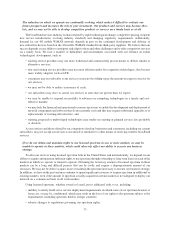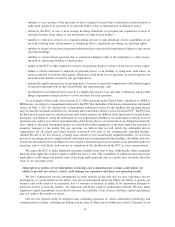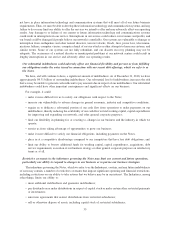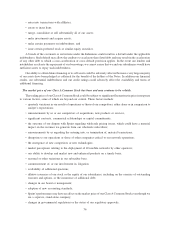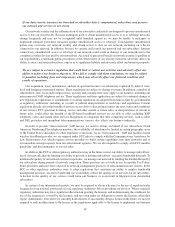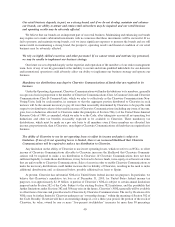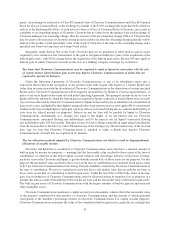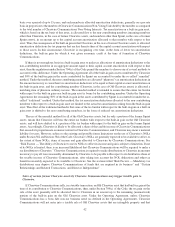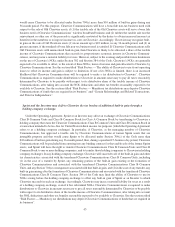Clearwire 2010 Annual Report Download - page 38
Download and view the complete annual report
Please find page 38 of the 2010 Clearwire annual report below. You can navigate through the pages in the report by either clicking on the pages listed below, or by using the keyword search tool below to find specific information within the annual report.The industries in which we operate are continually evolving, which makes it difficult to evaluate our
future prospects and increases the risk of your investment. Our products and services may become obso-
lete, and we may not be able to develop competitive products or services on a timely basis or at all.
The broadband services industry is characterized by rapid technological change, competitive pricing, frequent
new service introductions, evolving industry standards and changing regulatory requirements. Additionally,
demand for our 4G mobile WiMAX network depends in part on the continued development and delivery of
new subscriber devices based on the 4G mobile WiMAX standard from third-party suppliers. We believe that our
success depends on our ability to anticipate and adapt to these and other challenges and to offer competitive services
on a timely basis. We face a number of difficulties and uncertainties associated with our reliance on future
technological development, such as:
• existing service providers may use more traditional and commercially proven means to deliver similar or
alternative services;
• new and existing service providers may use more efficient and/or less expensive technologies, that become
more widely adopted, such as LTE;
• consumers may not subscribe to our services or may not be willing to pay the amount we expect to receive for
our services;
• we may not be able to realize economies of scale;
• our subscribers may elect to cancel our services at rates that are greater than we expect;
• we may be unable to respond successfully to advances in competing technologies in a timely and cost-
effective manner;
• we may lack the financial and operational resources necessary to enable the development and deployment of
network components and software that do not currently exist and that may require substantial upgrades to or
replacements of existing infrastructure; and
• existing, proposed or undeveloped technologies may render our existing or planned services less profitable
or obsolete.
As our services and those offered by our competitors develop, businesses and consumers, including our current
subscribers, may not accept our services as an attractive alternative to other means of receiving wireless broadband
services.
If we do not obtain and maintain rights to use licensed spectrum in one or more markets, we may be
unable to operate in these markets, which could adversely affect our ability to execute our business
strategy.
To offer our services using licensed spectrum both in the United States and internationally, we depend on our
ability to acquire and maintain sufficient rights to use spectrum through ownership or long-term leases in each of the
markets in which we operate or intend to operate. Obtaining the necessary amount of licensed spectrum in these
markets can be a long and difficult process that can be costly and require a disproportionate amount of our
resources. We may not be able to acquire, lease or maintain the spectrum necessary to execute our business strategy.
In addition, we have in the past and may continue to spend significant resources to acquire spectrum in additional or
existing markets, even if the amount of spectrum actually acquired in certain markets is not adequate to deploy our
network on a commercial basis in all such markets.
Using licensed spectrum, whether owned or leased, poses additional risks to us, including:
• inability to satisfy build-out or service deployment requirements on which some of our spectrum licenses or
leases are, or may be, conditioned, which may result in the loss of our rights to the spectrum subject to the
requirements, including spectrum held in foreign countries;
• adverse changes to regulations governing our spectrum rights;
33


